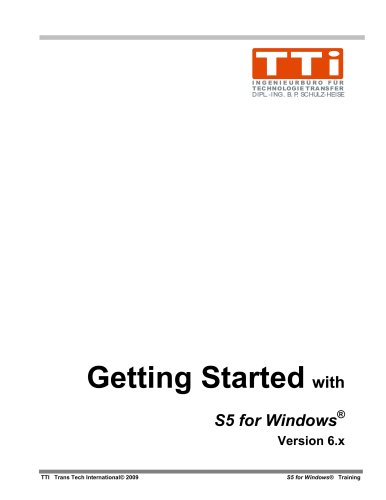
Catalog excerpts
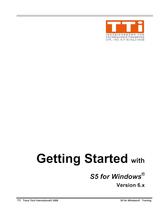
I NGENI E URBÜRO FÜR T EC HNOLOGI E T RA NS FE R DIPL. -I NG. B. P SCHULZ-HEISE . Getting Started with S5 for Windows® Version 6.x TTI Trans Tech International© 2009 S5 for Windows® Training
Open the catalog to page 1
Content The author has created this document to assist users of S5 for Windows® Version 6.X. In no way is the author responsible for the completeness or quality of the information provided. Liability claims regarding damage caused by the use of any information provided, will not be accepted. Part or all of the pages in the publication can be edited, altered, in part, or completely deleted by the author without separate announcement. Copyright The author has not knowingly used any copyrighted material for this publication. The copyright for any material created by the author is reserved. Any...
Open the catalog to page 2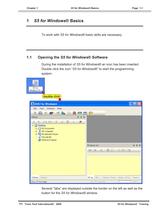
Chapter 1 1 S5 for Windows® Basics Page 1-1 S5 for Windows® Basics To work with S5 for Windows® basic skills are necessary. 1.1 Opening the S5 for Windows® Software During the installation of S5 for Windows® an icon has been inserted. Double click the icon “S5 for Windows®” to start the programming system. Several “tabs” are displayed outside the border on the left as well as the button for the S5 for Windows® window. TTI Trans Tech International© 2009 S5 for Windows® Training
Open the catalog to page 5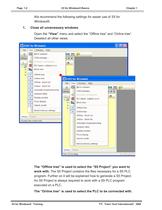
View Window Help Block compare Offline tree Online tree Offline - block list Online - block list Automatic troubleshooting Display module Force display Search results Restore factory settings Displays the online tree. Window Help Block compare Hardware configurator Block view Offline tree Online tree Offline - block list Online - block list Automatic troubleshooting Display module Force display Search results Restore factory settings Offline Online
Open the catalog to page 6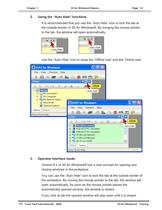
Chapter 1 2. S5 for Windows® Basics Page 1-3 Using the “Auto Hide” functions. It is recommended that you use the “Auto Hide” icon to lock the tab at the outside border of S5 for Windows®. By bringing the mouse pointer to the tab, the window will open automatically. Use the “Auto Hide” icon to close the “Offline tree” and the “Online tree”. 3. Operator Interface mode. Version 6.x of S5 for Windows® has a new concept for opening and closing windows in the workplace. You can use the “Auto Hide” icon to lock the tab at the outside border of the workplace. By moving the mouse pointer to the tab,...
Open the catalog to page 7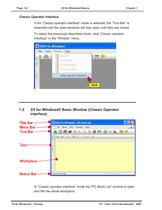
Page 1-4 S5 for Windows® Basics Chapter 1 Classic Operator Interface If the “Classic operator interface” mode is selected, the “Tool Bar” is extended and the open windows will stay open until they are closed. To select the previously described mode, click “Classic operator interface” in the “Window” menu. 1.2 S5 for Windows® Basic Window (Classic Operator interface) In “Classic operator interface” mode the “PC Block List” window is open and fills the whole workplace. S5 for Windows® Training TTI Trans Tech International© 2009
Open the catalog to page 8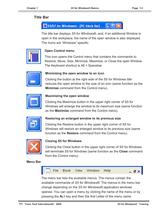
Chapter 1 S5 for Windows® Basics Page 1-5 Title Bar The title bar displays S5 for Windows®, and, if an additional Window is open in the workplace, the name of the open window is also displayed. The Icons are “Windows” specific. Open Control menu This icon opens the Control menu that contains the commands to Restore, Move, Size, Minimize, Maximize, or Close the open Window. The Keyboard shortcut is Alt + Spacebar. Minimizing the open window to an icon Clicking the button at the right side of the S5 for Windows title reduces the open window to the size of an icon (same function as the...
Open the catalog to page 9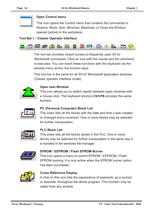
Page 1-6 S5 for Windows® Basics Chapter 1 Open Control menu This icon opens the Control menu that contains the commands to Restore, Move, Size, Minimize, Maximize, or Close the Window opened (active) in the workplace. Tool Bar I – Classic Operator Interface The tool bar provides instant access to frequently used S5 for Windows® commands. Click an icon with the mouse and the command is executed. You can reach these functions with the keyboard via the window menu and/or the function keys. This tool bar is the same for all S5 for Windows® application windows (Classic operator interface mode)....
Open the catalog to page 10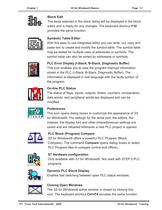
Chapter 1 S5 for Windows® Basics Page 1-7 Block Edit The block selected in the block listing will be displayed in the block editor and is ready for any changes. The keyboard shortcut F10 provides the same function. Symbolic Table Editor With this easy to use integrated editor you can write, cut, copy and paste text to create and modify the symbol table. The symbol table may be tested for multiple uses of addresses or symbols. The symbol table can also be sorted by addresses or symbols. PLC Error Display (I-Stack, B-Stack, Diagnostic Buffer) This icon enables you to view the program...
Open the catalog to page 11
Page 1-8 S5 for Windows® Basics Chapter 1 Help Function An integrated, subject related help file with an index and a list of keyboard shortcuts for easy operation is available. The keyboard shortcut F1 provides the same function. Tool bar II (PLC Block List) The tool bar II provides instant access to frequently used PC block list commands. Click an icon with the mouse and the command is executed. With the keyboard you can reach these functions via the file menu and the Block menu. Create new PLC Block A dialog box to establish the name of the new block is opened. After entering the new...
Open the catalog to page 12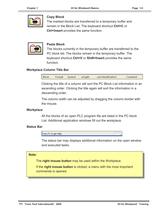
Chapter 1 S5 for Windows® Basics Page 1-9 Copy Block The marked blocks are transferred to a temporary buffer and remain in the Block List. The keyboard shortcut Ctrl+C or Ctrl+Insert provides the same function. Paste Block The blocks currently in the temporary buffer are transferred to the PC block list. The blocks remain in the temporary buffer. The keyboard shortcut Ctrl+V or Shift+Insert provides the same function. Workplace Column Title Bar Clicking the title of a column will sort the PC Block List information in an ascending order. Clicking the title again will sort the information in...
Open the catalog to page 13All IBH Softec catalogs and technical brochures
-
S7 for Windows Getting Started
89 Pages

